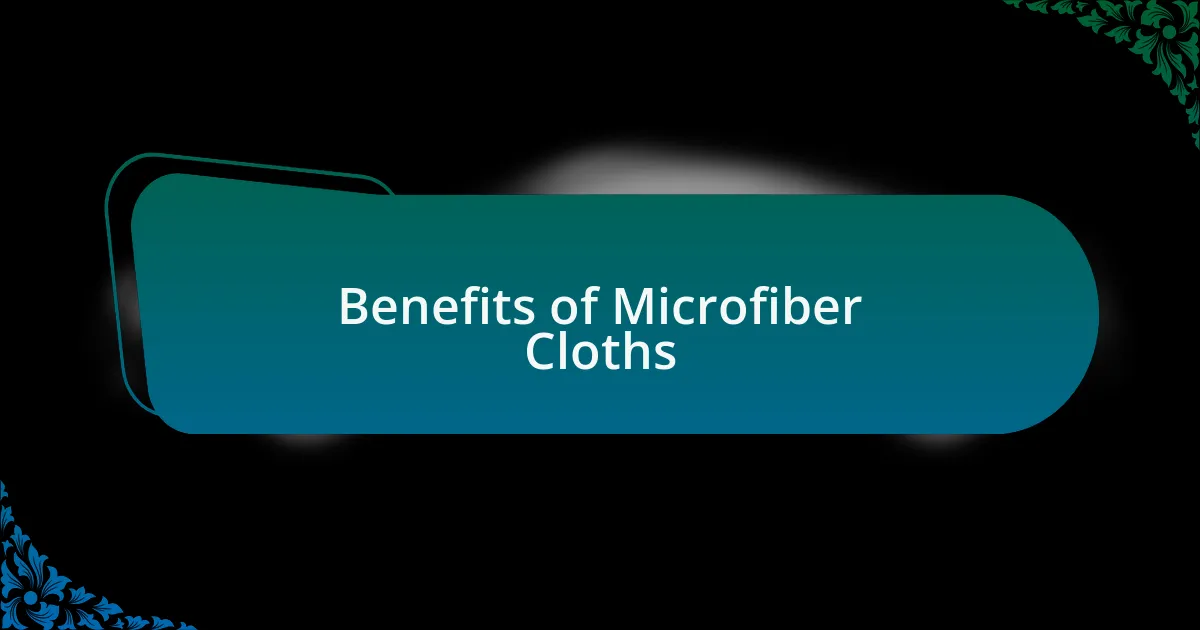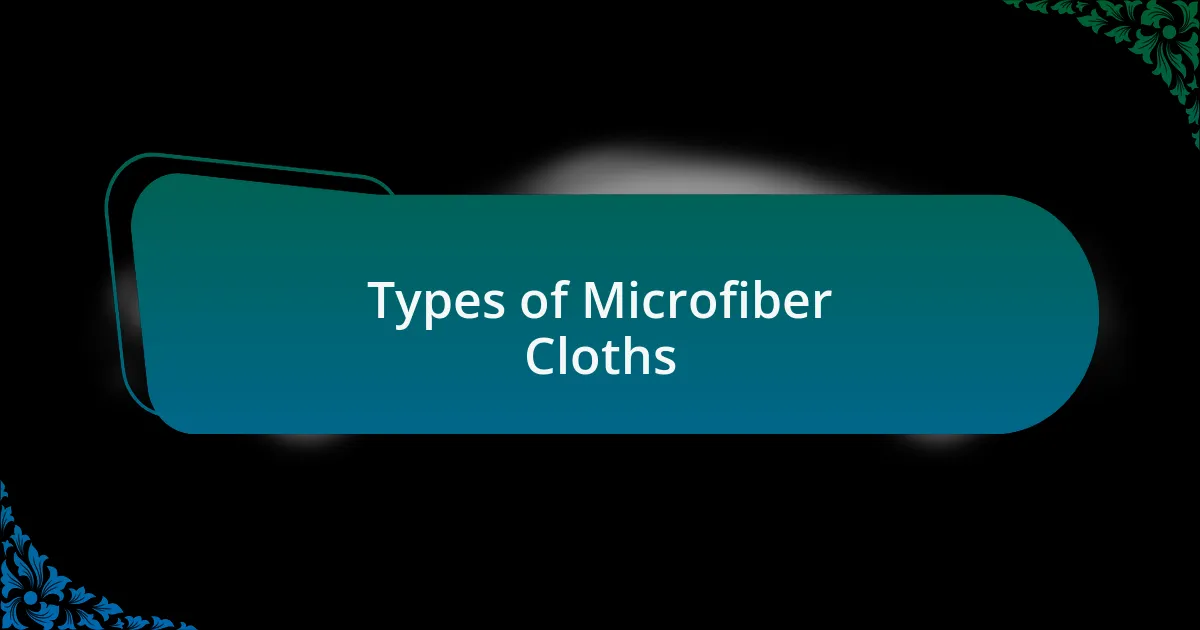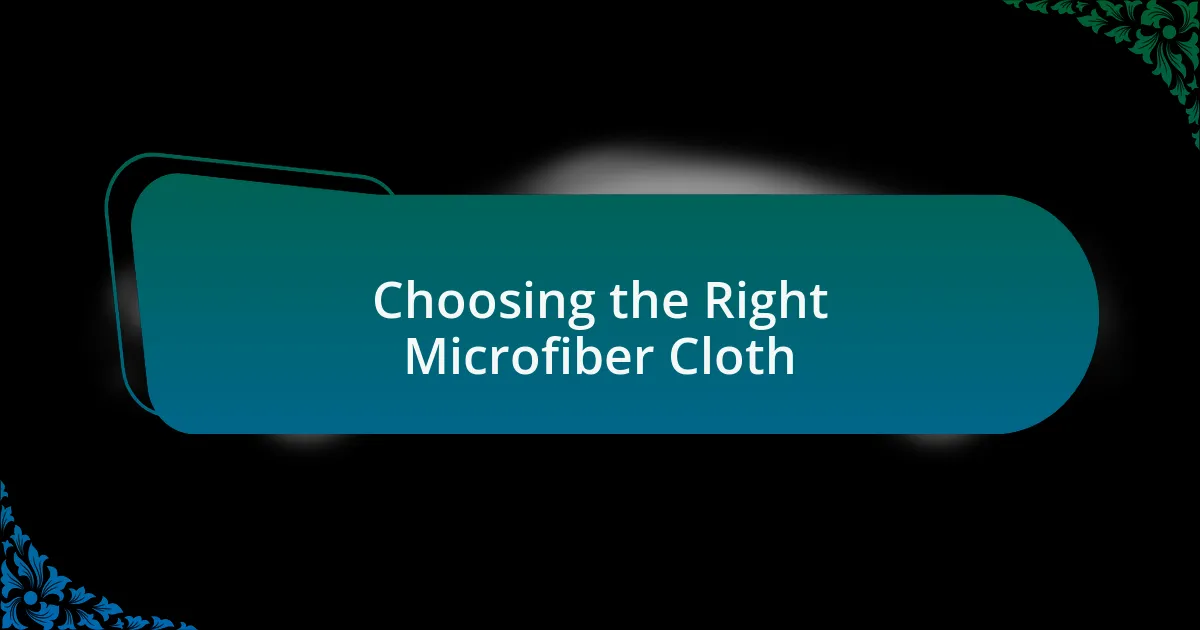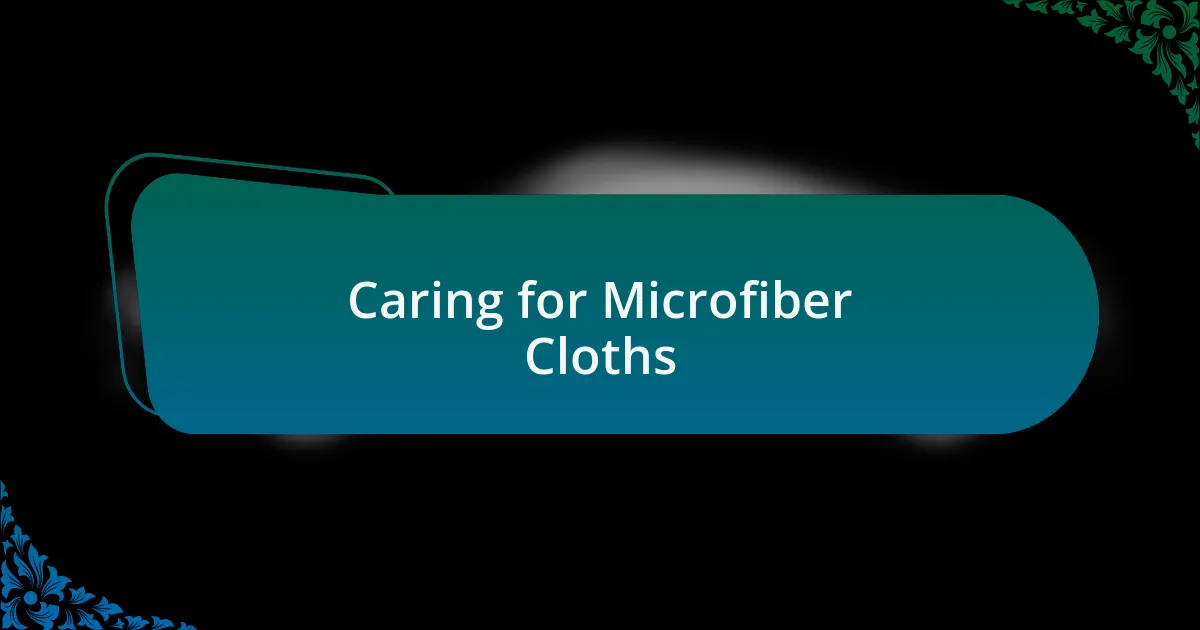Key takeaways:
- Microfiber cloths are effective cleaning tools that require no harsh chemicals and can outperform traditional methods.
- Choosing the right type of microfiber cloth enhances cleaning efficiency, with different types designed for specific tasks like drying, polishing, and glass cleaning.
- Caring for microfiber cloths properly, including using gentle detergents and avoiding fabric softeners, is essential for maintaining their effectiveness and longevity.
- Effective usage techniques, such as folding cloths and using separate cloths for each cleaning step, ensure optimal results and prevent cross-contamination.

Understanding Microfiber Cloths
Microfiber cloths are fascinating tools that have revolutionized cleaning, especially for car care. What sets them apart is their unique structure; they’re made of ultra-fine fibers that are significantly thinner than human hair. I remember the first time I used a microfiber cloth on my car’s dashboard—there was something satisfying about watching the dust vanish without any streaks or scratches.
One of the best aspects of microfiber cloths is their ability to hold onto dirt and grime without the need for harsh chemicals. It’s incredible to think that a simple cloth can outperform traditional cleaning methods. Have you ever wondered why some people swear by them? For me, it’s the peace of mind knowing I’m using something effective yet gentle on my car’s surfaces.
Different types of microfiber cloths are designed for various cleaning tasks, from detailing to drying. When I stumbled across a plush microfiber towel for drying my car, it felt like a game changer. The absorbency was outstanding, and it left my car looking spotless, just like after a professional wash. Choosing the right type can truly enhance your car care routine, making it more efficient and enjoyable.

Benefits of Microfiber Cloths
Microfiber cloths are a game changer when it comes to cleaning efficiency. I’ve experienced how they attract dust and grime like a magnet, which means less time spent scrubbing and more time enjoying a spotless car. There’s a sense of satisfaction in watching dirt lift away effortlessly, transforming the cleaning experience into something almost enjoyable.
One benefit that truly stands out for me is their softness. Unlike traditional cloths that can scratch paint, microfiber is gentle on surfaces. I recall a time when I cautiously wiped my car’s sensitive interior, expecting the worst. To my surprise, there were no scratches or swirls left behind—only a beautifully clean surface. Have you ever wished for that kind of reassurance while cleaning?
Another great aspect is their reusability, making them not just effective but also eco-friendly. I love knowing that I can wash and reuse my microfiber cloths several times, reducing waste. This has become a core part of my car care routine—less impact on the environment and more savings on cleaning supplies. It feels rewarding to contribute to a cleaner planet while ensuring my car shines like new!

Types of Microfiber Cloths
When it comes to types of microfiber cloths, you’ll find several options tailored for specific cleaning tasks. For instance, I often use plush microfiber cloths for my car’s interior. Their larger fibers seem to grab and hold onto dirt and dust better, giving me peace of mind that I’m not just pushing grime around. Don’t you love the feeling of knowing that every wipe leaves behind a spotless surface?
Then there are the sleek, thinner microfiber cloths, which I find perfect for glass surfaces. They don’t leave lint or streaks, making my car windows sparkle without the frustrating residue that some products leave behind. I remember the first time I finished cleaning my windshield with one of these; it felt like driving a brand new car, free from smudges and distractions. Isn’t it amazing how such a simple tool can enhance your driving experience?
Another option worth mentioning is the terry microfiber cloth. These are fantastic for polishing because they have a textured surface that aids in buffing up the finish on your paint. I often keep a couple of these in my detailing kit. They add that extra shine, making my car look showroom-ready. Have you experienced that proud moment when other drivers notice your car’s finish? It’s a rewarding feeling that makes the effort so worthwhile!

Choosing the Right Microfiber Cloth
When choosing the right microfiber cloth, consider the weight and weave. For example, heavier cloths tend to absorb more liquid, which is perfect for washing and drying. I remember a time when I opted for a lightweight cloth, thinking it would be efficient, but I ended up redoing my drying job. Have you experienced that frustration before?
Another factor to consider is the color of the microfiber cloth. Bright colors can sometimes help in tracking dirt and grime, allowing you to reserve specific cloths for different tasks. I often use a dark cloth for cleaning tires and wheels and a light one for the dash. It’s like having a secret weapon against cross-contamination. Isn’t it satisfying to know you’re keeping your surfaces as clean as possible?
Lastly, don’t overlook the importance of the cloth’s edge. Edgeless microfiber cloths are less likely to cause scratches, which is a concern I always bear in mind during detailing. I’ll never forget the moment I mistakenly used a cloth with a rough edge on my car’s paint and lived with the regret of those tiny scratches. Have you ever been in a similar predicament? This is why I prioritize choosing the right microfiber cloth; it truly impacts the quality of my detailing.

Proper Usage Techniques
Using microfiber cloths effectively is essential for achieving the best results in car detailing. I always start with a clean cloth; if it’s dirty, I might just spread grime around instead of removing it. One time, I rushed to dry my car with a cloth I thought was clean, only to realize too late that it had picked up dirt from a previous cleaning. Have you ever had a moment like that where a small oversight turned into a larger issue?
When I wash my car, I use a specific technique to maximize the cloth’s absorbency. I typically fold the cloth into quarters, allowing me to utilize all sides without continually grabbing a new one. This way, I avoid contaminating the clean areas with dirt. It’s a small change that makes a big difference—have you tried folding your cloths?
Also, I can’t stress enough the importance of using a different microfiber cloth for each step of the cleaning process. For instance, I always use a designated cloth for applying wax and another for buffing it off. This practice helps prevent cross-contamination and ensures a smooth finish. Have you experienced the satisfaction of a perfectly polished surface? For me, that’s what keeps me coming back to detailing my car.

Caring for Microfiber Cloths
Caring for microfiber cloths is critical if you want them to last and perform well. I often find that a simple wash can make a world of difference. I remember mistakenly tossing a pile of microfiber cloths in with regular laundry and ending up with lint-covered cloths that were no longer effective. Have you ever made that mistake? It’s disheartening to see your tools degrade because of carelessness.
When washing my microfiber cloths, I use a gentle detergent designed specifically for them, and I avoid fabric softeners entirely. They can clog the fibers, which diminishes their effectiveness. I’ve seen firsthand how this small step can keep my cloths soft and absorbent, enhancing their cleaning capabilities. Plus, I always wash them in cold water; I noticed warm water can cause unwanted shrinkage over time.
Drying microfiber cloths is another step where I take extra care. I opt for air drying whenever I can, but if I must use a dryer, I set it on low heat. I learned the hard way that high heat can degrade the fibers, leaving my once-pristine cloths less effective. It’s all about longevity and performance—don’t you want your microfiber cloths to serve you well for as long as possible?